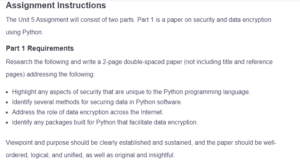Unit 5 Assignment Security and File Processing
The Python programming language has a simple syntax that is popular among programming learners as well as experts (Adawadkar, 2017). It is also a high-level language, making it easy for humans to understand as compared to machine and assembly languages which are low-level programming languages. Python has an extensible interpreter and a vast library, making it efficient. The language can be used with other applications by embedding it.
Highlight any aspects of security that are unique to the Python programming language.
Python programming is recommended for cybersecurity (Wang et al., 2020). It offers web security for web browsers. Because of its highly effective data security features, Python is used in computer vision, big data, robotics, automation testing, and machine learning (Wang et al., 2020). Python also offers high memory safety. This is implemented through MesaPy. The Python programming language also has a simple syntax that makes documenting code easy and fast.
Identify several methods for securing data in Python software.
To ensure that Python programming is kept safe, MesaPy should be used (Wang et al., 2020). MesaPy is a Python interpreter that is memory-safe. This memory-safe interpreter reinforces security in PyPy, where the interpreter was developed using the C and C++ programming languages. Data encryption packages can also be used to secure data in Python. This ensures that a hacker or a malicious person does not have access to the data. Some of the encryption packages in Python include cryptography, hashlib, and simple-cript (Sharma, 2020). An encryption key and decryption key are known to both the sender and receiver. The data encryption packages facilitate the importation and execution of encryption functions such as fernet and hash.
Address the role of data encryption across the Internet.
Data encryption and decryption are done under cryptography (Gençoğlu, 2019). Encryption facilitates the encoding of a message from plain text to unreadable format. The encrypted message is then transmitted from the sender to the receiver. Upon reaching the sender, the message is decoded and returned into plaintext for the receiver to read. A sender encrypts plaintext with an encryption key that requires the receiver to have a decryption key (Gençoğlu, 2019). The encrypting and decrypting exercise is necessary to ensure that only authorized parties can read a transmitted message. The Internet has a large web of computers where hackers might pose as legal persons with the intent to intercept or eavesdrop on a message in transit. Therefore, data encryption keeps hackers and all other cybercriminals at bay.
Identify any packages built for Python that facilitate data encryption.
Cryptography is one of the packages used in Python for data encryption and decryption (Sharma, 2020). To use cryptography in Python, the Fernet function is imported. An encryption key is generated and loaded before data is encrypted. During data decryption, the key that was used to encrypt data would be used. Simple-crypt is another package that is used in Python to encrypt data (Sharma, 2020). The decrypt and encrypt functions are used under the simple-crypt package. These functions are used to decrypt and encrypt data in Python. Hashlib is the third Python library used in encrypting data (Sharma, 2020). The hash function accepts input in the form of variable length and provides an output of fixed length. This ensures data integrity and safety.
References
Adawadkar, K. (2017). Python Programming-Applications and Future. International Journal of Advance Engineering and Research Development, 1-4. Retrieved from http://ijaerd.com/papers/special_papers/IT032.pdf
Gençoğlu, M. T. (2019). Importance of Cryptography in Information Security. IOSR Journal of Computer Engineering (IOSR-JCE), 21(1), 65-68. Retrieved from https://www.researchgate.net/publication/331641251_Importance_of_Cryptography_in_Information_Security
Sharma, H. (2020, July 27). Implementing encryption and decryption of data in Python. Retrieved from https://analyticsindiamag.com/implementing-encryption-and-decryption-of-data-in-python/
Wang, H., Sun, M., Feng, Q., Wang, P., Li, T., & Ding, Y. (2020). Towards Memory Safe Python Enclave for Security Sensitive Computation. Retrieved from https://arxiv.org/pdf/2005.05996.pdf
ORDER A PLAGIARISM-FREE PAPER HERE
We’ll write everything from scratch
Question 
Unit 5 Assignment Security and File Processing
Outcomes addressed in this assignment:
Unit Outcomes:

Unit 5 Assignment Security and File Processing
- Investigate the role of security in programming.
- Examine file input and output.
Course Outcomes:
- GEL-1.02:Demonstrate college-level communication through the composition of original materials in Standard English.
- IT244-2:Analyze user-defined functions and classes in Python.
Purpose
The written assignment for this unit gives you an opportunity to reflect on the role of security and data encryption in the Python pro language and the world in general. The programming assignment lets you demonstrate the ability to utilize file access techniques Python.
Assignment Instructions
The Unit 5 Assignment will consist of two parts. Part 1 is a paper on security and data encryption using Python.
Part 1 Requirements
Research the following and write a 2-page double-spaced paper (not including title and reference pages) addressing the following:
- Highlight any aspects of security that are unique to the Python programming language.
- Identify several methods for securing data in Python software.
- Address the role of data encryption across the Internet.
- Identify any packages built for Python that facilitate data encryption.
Viewpoint and purpose should be clearly established and sustained, and the paper should be well-ordered, logical, and unified, as well as original and insightful.
Assignment should follow the conventions of Standard English (correct spelling, grammar, and punctuation) and be in APA format with separate title and reference pages formatted per APA guidelines. For more information on APA style formatting, go to Academic Writer, formerly APA Style Central, under the Academic Tools area of this course to assist you in meeting APA expectations.